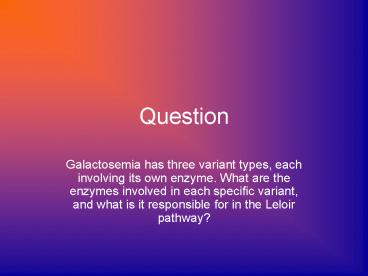Question - PowerPoint PPT Presentation
1 / 22
Title:
Question
Description:
What are the enzymes involved in each specific variant, and what is it ... The bulkier side chain of tyr causes steric hinderance. Improper folding of the protein ... – PowerPoint PPT presentation
Number of Views:67
Avg rating:3.0/5.0
Title: Question
1
Question
- Galactosemia has three variant types, each
involving its own enzyme. What are the enzymes
involved in each specific variant, and what is it
responsible for in the Leloir pathway?
2
Galactosemia
- By Brandon Sebring
3
What is Galactosemia?
- Autosomal Recessive Disorder
- Inability to properly metabolize Galactose
4
- http//en.wikipedia.org/wiki/Galactose
- http//en.wikipedia.org/wiki/Glucose
5
Symptoms
- Cataracts
- Mental Retardation
- Diarrhea
- Jaundice
- Stunted Growth
- Death
6
Leloir Pathway
Voet and Voet
7
Types of Galactosemia
- Three types of Galactosemia
- Type II Galactosemia
- Classical (Type I) Galactosemia
- Type III Galactosemia
- Peripheral
- Generalized
8
Type II Galactosemia
- Involves Galactokinase
- Conversion of Galactose to Galactose-1-phosphate
- Extra Galactose Transported to eye cells
- High amounts of Aldose Reductase
- Causes Cataracts
- Cataracts form from Galacticol Build up
9
Leloir Pathway
Voet and Voet
10
How Galactokinase works
- ATP enters the active site and is bound to the
guanidinium group of Arg-36 - Galactose enters and is bound by its C-1 hydroxyl
group to the Asp-183 residue and the guanidinium
group of the Arg-36 residue - Galactokinase transfers the phosphate from ATP to
the C-1 hydroxyl group by removing the hydrogen,
lowering the pKa of the hydroxyl group - ADP and Gal-1-P are released
11
Galactokinase Mutation
- Normal galactokinases active site contains a
highly reserved histidine residue(His44) which
forms part of the binding site for the galactose
substrate - In the mutation, His44 is replaced by a tyrosine
and is known as the H44Y mutation - The bulkier side chain of tyr causes steric
hinderance - Improper folding of the protein
- Decreases interaction with Galactose
12
Classical Galactosemia
- Utilizes Galactose-1-phosphateuridylyl
transferase (GALT) - Converts Galactose-1-phosphate to UDP-Galactose
- Converts UDP-Glucose to Glucose-1-phosphate
- Acts as a dimer, completing two half reactions
simultaneously
13
Leloir Pathway
Voet and Voet
14
How GALT Works
- Gal-1-P enters active site and attacks the
uridylylated nitrogen of the his in active site - Dissociates with the uridylyl group
- UDP Glucose enters the UMP-GALT site and is
attacked by the his N residue from first half rxn - G-1-P formed
15
Classic Galactosemia Symptoms
- Build up of Galactose-1-phosphate
- Jaundice, diarrhea, vomitting, mental
retardation, ovarian failure - Most common leads to death by age 2
16
Type III Galactosemia
- Involves UDP-galactose-4-epimerase (GALE)
- Converts UDP-Galactose to UDP-Glucose
- Two Types Peripheral and Generalized
- Peripheral only affects the circulating red blood
cells, clinically benign - Generalized appears in all tissue cells and can
cause development issues
17
Leloir Pathway
Voet and Voet
18
How GALE Works
- The 4-hydroxyl hydrogen is extracted by an
enzymatic base and hydride is transferred from
C-4 of the sugar to the si-face of the
nicotinamide ring of NAD. - The resulting 4-keptopyranose intermediate in
the active site is rotated to present the
opposite face of the sugar to the reduced
dinucleotide. - In the last step, the hydride from the
nicotinamide ring of NADH is transferred back to
the C-4 of the sugar and the C-4 oxygen is
reprotonated
19
http//www.uic.edu/classes/bios/bios100/lectf03am/
NADH.jpghttp//www.uic.edu/classes/phar/phar332/C
linical_Cases/carbo20metab20cases/udp-glu.gif
20
Type III Symptoms
- Peripheral Slight decrease in the hGALE activity
in the RBCs and WBCs - Generalized Displays non-lethal symptoms of
Classic Galactosemia (diarrhea, vomitting, growth
issues, and premature ovarian failure)
21
Treatments
- Type I Screening done at early ages, diet
consisting of no galactose or lactosestill may
not live past 10 years of age - Type II Diet consisting of no galactose or
lactose - Type III Diet consisting of no galactose or
glucose
22
The End

